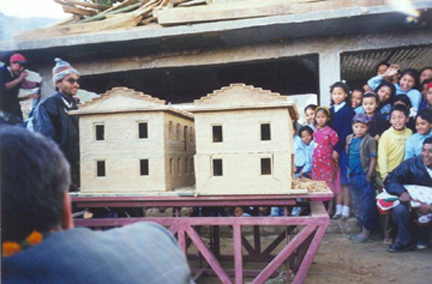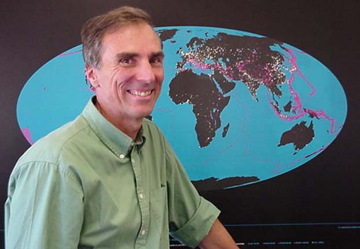Geotimes

Web Extra
Friday, October 4
Seismologist wins 'Genius Grant'

In 1949, Tajikistan was hit by a devastating earthquake that killed more than
20,000 people. Twenty-eight years later, Brian Tucker, who had just finished
his Ph.D. in seismology, found himself in Tajikistan as part of an exchange
program between the Soviet Union and the U.S. Geological Survey. In a small
town in the mountains, Tucker met a man whose childhood home had been the only
building to withstand the earthquake. The man's father had constructed the house
in a nontraditional ways with thick timbers in the corners.
"The irony is that here we were standing in the only building in the whole
village that stood up under the earthquake and I asked the man: 'So, if you
build a new house how will you build it? And the man answered, 'Oh, in the traditional
way. My dad was a real kook,'" Tucker says.
Nankhel, Nepal. Villagers look
on as a shaker table tosses around scale models of local buildings. The model
on the right represents a building using traditional construction techniques;
the one on the left is the same building except with a couple simple additions
to mitigate earthquake risk. The building on the right is just beginning to
collapse, and collapses totally several minutes later, driving home the importance
of improved construction strategies in the earthquake-prone village. Photo by
Laura Dwelley-Samant.
It was on this trip that Tucker realized that simple changes in building design
can dramatically reduce the risk of deaths and injuries from earthquakes in
developing countries; but also that many people had not taken those steps. The
realization planted the seed for a nonprofit that Tucker founded 14 years later.
The John D. and Catherine T. MacArthur Foundation announced on Sept. 25 that
Tucker is one of 24 people to receive what is often called the "Genius
Grant," $500,000 with no strings attached to pursue his interests. Given
as part of the MacArthur Fellows Program, the award recognizes past creativity,
which Tucker demonstrated when he founded GeoHazards International (GHI) in
1991 - the first nonprofit, nongovernmental organization dedicated to mitigating
earthquake risks in the world's poorest and most vulnerable regions.
"Brian is not afraid to follow his gut instinct. He didn't know when
he started [GHI] where it was going to go. He knew he wanted to work on the
problem and just dove in and started working. It was a risky and daring approach,"
says Laura Samant, project director at GHI.
GHI has retrofitted schools in Ecuador and Nepal, built a hazard assessment
organization in Nepal, and is currently working on similar projects in India.
Four of five deaths caused by earthquakes in the last centruy occurred in developing
countries. But the low frequency of the events makes the threat invisible to
many people. "We work with people on the other side of the world, often
on a hazard that they do not know about," Tucker says. So making people
aware of the seriousness of the risk is critical.
For example, in the town of Nankhel in the Katmandu Valley, Nepal, GHI workers
built two 1:10 scale models of an important building in the town. One model
represented the building as it is today. The other represented the same building
except with a couple simple engineering additions to make the building more
secure. A crowd of townspeople watched as a shaker table tossed the models around,
simulating an earthquake. The revamped building stood, while the other fell
apart, driving home both the risks of earthquakes and the importance of well-engineered
buildings.
In Nepal, the organization has strengthened nine schools to resist earthquake
damage. Most schools in Nepal are built of brick and cannot withstand much tension
force. When an earthquake hits, the base of the building shakes in all directions
and tension forces bring the walls down. Town masons and engineers from the
GHI office worked together to retrofit the schools by wrapping bands of reinforced
concrete around the outsides of the buildings to hold the walls together during
an earthquake. The walls move in unison, and thus experience less of the devastating
tension force.
 Funding for
GHI comes primarily from philanthropy. When Tucker began thinking about forming
the nonprofit, he went to some good friends in Japan who worked for the geotechnical
company Oyo. "They shared the vision that engineering skills developed
in the U.S., Japan and Europe should be applied to reduce risks in developing
countries," Tucker says. Through a combination of personal and corporate
donations, the Japanese partners came up with the startup money for the non-profit.
The goal was for the organization to become self-sufficient, and they are "pretty
much there," Tucker says.
Funding for
GHI comes primarily from philanthropy. When Tucker began thinking about forming
the nonprofit, he went to some good friends in Japan who worked for the geotechnical
company Oyo. "They shared the vision that engineering skills developed
in the U.S., Japan and Europe should be applied to reduce risks in developing
countries," Tucker says. Through a combination of personal and corporate
donations, the Japanese partners came up with the startup money for the non-profit.
The goal was for the organization to become self-sufficient, and they are "pretty
much there," Tucker says.
Brian Tucker stands in front of a map
indicating earthquake hot zones throughout the world. Photo by Janifer Stackhouse.
Tucker served as principal and supervising geologist at the California Division
of Mines and Geology, the State's Geological Survey, for nine years before founding
GHI. Tucker enjoyed his job applying science to public policy in California.
Yet, he says: "it was clear to me that the real need was in developing
countries. There were so many experts working on seismology problems in California."
Tucker does not yet have specific plans for the money from the MacArthur award.
But he says the part of the award he values most is not the money; rather, it
is the recognition of the work he and his colleagues do at GHI. "When I
got the call - the MacArthur Foundation validating and recognizing our work
- it was just the greatest thing I could imagine."
Two other earth scientists were awarded the MacArthur Fellowship this year.
Lee Ann Newsom is a paleoethnobotanist at the Pennsylvania State University.
She analyzes fossilized plant and wood remains to look back at how prehistoric
populations used their natural resources. Paul Wennberg is an atmospheric chemist
at the California Institute of Technology. He has developed sensitive, airborne
sensors that help clarify the factors governing ozone depletion.
Greg Peterson
Links:
GeoHazards International
The MacArthur
Fellows Program, including in-depth discussions of award winners Newsom
and Wennberg
 Funding for
GHI comes primarily from philanthropy. When Tucker began thinking about forming
the nonprofit, he went to some good friends in Japan who worked for the geotechnical
company Oyo. "They shared the vision that engineering skills developed
in the U.S., Japan and Europe should be applied to reduce risks in developing
countries," Tucker says. Through a combination of personal and corporate
donations, the Japanese partners came up with the startup money for the non-profit.
The goal was for the organization to become self-sufficient, and they are "pretty
much there," Tucker says.
Funding for
GHI comes primarily from philanthropy. When Tucker began thinking about forming
the nonprofit, he went to some good friends in Japan who worked for the geotechnical
company Oyo. "They shared the vision that engineering skills developed
in the U.S., Japan and Europe should be applied to reduce risks in developing
countries," Tucker says. Through a combination of personal and corporate
donations, the Japanese partners came up with the startup money for the non-profit.
The goal was for the organization to become self-sufficient, and they are "pretty
much there," Tucker says.

